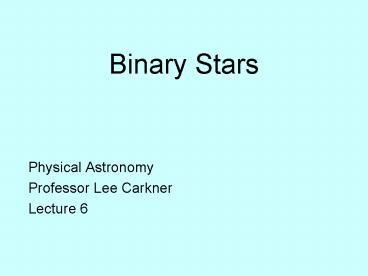Binary Stars
1 / 13
Title: Binary Stars
1
Binary Stars
- Physical Astronomy
- Professor Lee Carkner
- Lecture 6
2
Questions
- 1) Consider a planet of mass m in a circular
orbit of radius R around a star of mass M. What
is the gravitational potential energy? - U -(GMm/R)
- 2) What is the kinetic energy of the planet?
- K ½mv2
- 3) If you equate gravitational and centripetal
force, what is the velocity? - GMm/R2 mv2/R
- v2 GM/R
- 4) Does the virial theorem hold?
- K ½m(GM/R) ½(GMm/R) -½U
- (yes)
3
Visual Binaries
- Consider a binary star composed of two masses in
two elliptical orbits around the center of mass
(cm) - m1/m2 a2/a1
- a1 a1/d
- m1/m2 a2/a1
- even if we dont know the distance, if we can
measure as we can find the mass ratio
cm
a
4
Finding Mass
- Since a a1 a2, Keplers 3rd law gives
- P2 (4p2a3)/G(m1m2)
- Have to use m1m2 and m1/m2 to pull out ms
separately
5
Inclination
- The true orbit will be inclined to our line of
sight by an inclination angle, i - ? a cos i
- so Keplers third law becomes
- m1m2 (4p2/G)(d/cos i)3(?3/P2)
6
Spectroscopic Binaries
- Instead we measure velocity
- vr v sin i
- If we observe over time, velocity is periodic
- For circular, edge-on orbits, vmax is the true
orbital velocity
7
Mass and Velocity
- We can get the ratio of masses even if we dont
know i, - If we do know i,
- m1m2 (P/2pG)(v1rv2r)3/sin3 i
- Where we can measure both v1r and v2r
8
Inclination and Statistics
- Often we cant find i
- We cant find mass for one star, but we can find
an average mass for a class of stars - Gives mass-luminosity relationship
- How does mass produce luminosity?
9
Eclipsing Binaries
- Eclipsing binaries show changes in brightness
- From Doppler shift we can get the velocity of
each star - Smaller vs
- Larger vl
- Relative velocity v vs vl
10
Eclipsing Binaries and Radius
- rs (v/2)(tb-ta)
- Time for smaller to emerge from behind larger is
just tc-ta, so radius is - rl (v/2)(tc-ta)
11
Eclipse Brightness
- Maximum light B0
- Primary minimum Bp
- Secondary minimum Bs
- Cooler star completely behind hotter
12
Temperature
- B0-Bp
- B0-Bs
- Since flux is proportional to temperature,
- (B0-Bp)/(B0-Bs) 1-(Bp/B0)/1-(Bs/B0)
(Ts/Tl)4 - Note that B1/B2100(m2-m1)/5
13
Next Time
- Read 8.1
- Homework 7.5, 7.6, 8.1, 8.1, 8.6a































